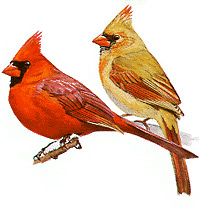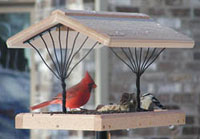Blog - General
Colorful Cardinals Bring Holiday Cheer
Can anything beat the sight of a bright red Cardinal against a backdrop of white snow? As a resident of the Eastern Great Plains, the Northern Cardinal is a faithful visitor to feeders and can be one of the easier species to attract. It is such a popular and widespread species throughout the east, that it is the state bird for seven states and the mascot for professional baseball and football teams. 
The Cardinal’s heavy triangular beak is red, contrasted by a black throat on the male. Their name comes from the red robes worn by Roman Catholic cardinals. The female is brownish overall with reddish highlights on the wings and tail. In the summer, dark beaked juvenile birds come in a variety of “half-baked” plumages, with a mixing and mottling of red and brown. The crested head is another good field mark for adults and may be missing or shaggy on the juveniles. Spring through fall their clear slurred and whistled song “Cheer, Cheer, Cheer!” rings throughout the landscape, with females joining the singing too. Year round, listen for their incessant, short metallic calls and occasional bursts of song.
Cardinals live in a wide variety of habitats including woodland edges, thickets, forests, swamps, urban areas and gardens. They are typically seen alone or in small groups. To encourage nesting, plant vines, thickets, and fruit-bearing shrubbery. During the courtship process, the male will feed seeds to the female. This also prepares him to take care of the young birds while she starts another nesting cycle.
Their diet consists primarily of seeds and berries supplemented by insects, especially during the breeding season. Preferred seeds include sunflower, safflower and peanut parts which are coincidentally the ingredients of our Cardinal Blend. They prefer feeding on or near the ground and are often the first to arrive at feeders in the morning and the last to leave at the end of the day.

Since Cardinals are larger birds they prefer a larger perching area. Hanging or post mounted platform feeders are ideal. From my experience, this style of bird feeder is used by Cardinals most often – probably because of its large flat surface, and the birds feel very safe since they can see in all directions. Ground bird feeders are another style which Cardinals seem to approve of. But since squirrels are an issue in my yard I use a mix of Safflower seed and white Proso millet on all my ground feeders. Hopper style feeders with a large perching area work great as well. The advantage here is they have the capacity to hold a quantity of bird seed, requiring fewer trips to fill them.
Although the durability and natural look of these feeders made from Inland Red Cedar continue to be preferred, the new line of feeders made from 100% post consumer recycled plastic is gaining in popularity. Many of these bird feeders have a 20 year warranty against fading, pealing, cracking, and chipping. They clean up like brand new, even after years of use. And speak of easy cleaning, many of the cedar and recycled plastic feeders we stock have removable perforated steel bottoms. This also allows moisture to pass through and the seed to remain dry.
Since tube feeders have relatively short perches, Cardinals rarely use them. But you can make these feeders Cardinal-friendly by adding a seed tray or the Droll Yankee Cardinal Ring that attach to the perches.
The Northern Cardinal is a member of the Grosbeak and Bunting family which includes other species common in Nebraska. The Rose-breasted and Blue Grosbeaks, Black-headed Grosbeak, Indigo Bunting and Dickcissel are related. But the Cardinal is a year round resident where the others only occur from spring through early autumn.
